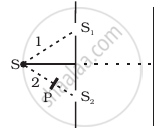Advertisements
Advertisements
प्रश्न
For the same objective, find the ratio of the least separation between two points to be distinguished by a microscope for light of 5000 Å and electrons accelerated through 100 V used as the illuminating substance.
उत्तर
Resolving power is the ability of an imaging device to separate (i.e., to see as distinct) points of an object that are located at a small angular distance or it is the power of an optical instrument to separate far–away objects, that are close together, into individual images. The term resolution or minimum resolvable distance is the minimum distance between distinguishable objects in an image, although the term is loosely used by many users of microscopes and telescopes to describe resolving power. In scientific analysis, in general, the term “resolution” is used to describe the precision with which any instrument measures the Ratio of the least separation,
For electrons accelerated through 100 V, the de-Broglie wavelength, is 12.27 and records (in an image or spectrum) any variable in the specimen or sample under study.
It is defined as the reciprocal of the smallest distance (Δx) between two point objects whose images are just resolved by the objective of the microscope. It is given by `R = 1/(Δx) = (2 sin α)/(1.22 μλ)` where μ as refractive index of the medium, α is the angle subtended by the objective at the object and λ is the wavelength of light.
de-Broglie wavelength: According to de-Broglie theory, the wavelength of de-Broglie wave is given by `lambda = h/p = h/(mv) = h/sqrt(2mE)` ⇒ `lambda oo 1/p oo 1/v oo 1/sqrt(E)` where h = Planck's constant, m = Mass of the particle, v = Speed of the particle, E = Energy of the particle.
The energy of a charged particle accelerated through potential difference V is `E = 1/2 mv^2 = qV`
Hence de-Broglie wavelength `lambda = h/p = h/sqrt(2mE) = h/sqrt(2mqV)`
For electron, `λ_("Electron") = 12.27/sqrt(V) Å`
We know that
Resolving power = `1/d = (2 sin α)/(1.22 λ)` ⇒ `d_("min") = (122 λ)/(2 sin α)`
Where λ is the wavelength of light and β is the angle subtended by the objective at the object.
For the light of wavelength 5500 Å,
`d_("min") = (1.22 xx 5500 xx 10^-10)/(2 sin α)` .......(i)
For electrons accelerated through 100 V, the de-Broglie wavelength,
`λ = 12.27/sqrt(V) = 12.27/sqrt(100) = 0.12 xx 10^-9 m`
`d_("min") = (122 xx 0.12 xx 10^-9)/(2 sin α)`
Ratio of the least separation, `d_("min")^'/d_("min") = (0.12 xx 10^-9)/(5500 xx 10^-10) = 0.2 xx 10^-3`
APPEARS IN
संबंधित प्रश्न
What is a Polaroid?
If the critical angle of a medium is sin-1(3/5), find the polarising angle.
How does one demonstrate, using a suitable diagram, that unpolarised light when passed through a Polaroid gets polarised?
A beam of unpolarised light is incident on a glass-air interface. Show, using a suitable ray diagram, that light reflected from the interface is totally polarised, when μ = tan iB, where μ is the refractive index of glass with respect to air and iB is the Brewster's angle.
Show, with the help of a diagram, how unpolarised sunlight gets polarised due to scattering.
Show, via a suitable diagram, how unpolarised light can be polarised by reflection.
What is the value of refractive index of a medium of polarising angle 60°?
Unpolarised light is incident on a polaroid. How would the intensity of transmitted light change when the polaroid is rotated?
Discuss polarisation by selective absorption.
Figure shown a two slit arrangement with a source which emits unpolarised light. P is a polariser with axis whose direction is not given. If I0 is the intensity of the principal maxima when no polariser is present, calculate in the present case, the intensity of the principal maxima as well as of the first minima.

